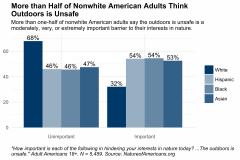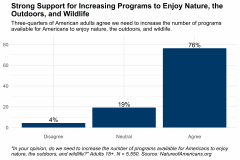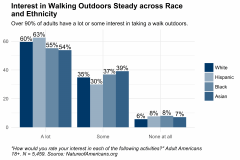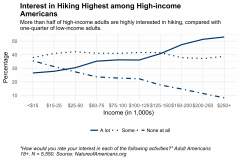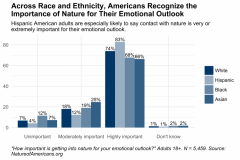2017 Conference Highlight: The Nature of Americans
(11/15/17)
Presentation by Dave Case, DJ Case & Associates
Summary by Marianne Burke
The Nature of Americans is new research on an old topic. If you have been in the conservation and education field as long as I have, you know the topic of connecting people with nature has been discussed at every major conference, meeting and gathering of great minds for a couple of decades. However, because it is an old topic does not mean it is not important. It is a very important topic. As technology and social media become more advanced and popular, connecting people with nature will continue to be a priority for our agencies. It is a topic I feel will forever be on our agendas.
In the late 1990s, our agencies were concerned with dropping license sales, and discussions centered on ways to stem the decline. In 2005, Richard Louv published a book titled Last Child in the Woods: Saving Our Children from Nature-Deficit Disorder. It discussed the results and dangers of children spending more time indoors with video games, malls and coffee shops. Louv’s research and book spurred a wave of successful programs and partnerships that focused on regaining the generation we lost.
Fast-forward to 2017. The need to promote interaction between people and nature has not subsided but has continued with new research, enthusiasm and a new generation of conservationists. The Nature of Americans has approached this old topic with new research and documentation that will perhaps better connect nature and people in our country as it is today.
The Nature of Americans study involved 12,000 Americans, including adult focus groups, online adult surveys and children interviews with surveys of their parents. When the surveys and interviews were completed, the study resulted in eight major findings. The following information is a summary of the findings with the top five recommendations.
FINDINGS
- Interest-action gap – This finding is exactly what it says. The gap between interests in nature and their ability to experience it was significant. The roadblocks to enjoying the outdoors are competing priorities, social media, lack of resources and individual locations.
- Nature is social – Memorable experiences in nature are those that are shared with others. When the survey asked adults about their experiences in nature, they referred to ones shared with other people.
- Where nature is located – Children perceived nature as something as simple as playing in the backyard. Adults tended to create more lavish nature scenarios, scenic or faraway places and trips, contributing to inaccessibility.
- Quality and quantity of places – Having access to many places to enjoy nature was important, but quality of the places, especially urban areas with crime, traffic and proximity was of equal importance.
- Valuing nature – Nature was valued in broad, diverse ways, including spiritual, intellectual, aesthetic appeal and physical benefits of nature.
- Nature related programming and funding – The majority of adults felt nature related programming is underfunded and supported different ways of funding nature and wildlife activities.
- Complex and nuanced relationships – Relationships with nature were varied and complex among different groups of Americans. Although there were some similar interests among all American groups, there were also substantial differences in particular activities.
- Benefits of nature – The majority of American adults agreed that experiences with nature are beneficial to their physical and emotional health. Children in the survey said being in nature made them happy.
RECOMMENDATIONS (Top 5)
- Redefine connecting with nature – Events needs to be routine and not once in a lifetime adventures. Propose activities as part of regular schedules and daily lives.
- Be social when connecting nature – Not social media. Invite pre-existing social groups to programs, and create and support mentorships.
- Consider similarities and differences in values and interests – Consider how Americans are different and similar in their relationships with nature. Americans are similar in that they like to experience nature with others. A concern of safety and the type of outdoor activities differs among groups.
- Promote multidimensional experiences – Do not limit it to just recreational experiences. Promote the mental and emotional benefits as well.
- Claim a seat at the table – Connecting Americans cannot always be about hunting, fishing, wildlife viewing or management tools. To have larger impact, future plans need to be included with discussions on health care, education, transportation, urban planning and other major topics in order to build partnerships with the proper communities.
The rest of the recommendations along with the entire study can be found at natureofamericans.org. The Nature of Americans offers valuable new research for the ongoing problem of connecting people with nature. As our country continues to grow in diversity, in-depth research such as this is vital to creating successful opportunities and programs for all groups of Americans. It is a helpful tool for the new generation of conservationists to battle an old problem.

